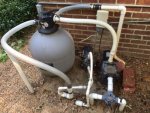- Jul 9, 2016
- 227
- Pool Size
- 24000
- Surface
- Vinyl
- Chlorine
- Salt Water Generator
- SWG Type
- Pureline Crystal Pure 60,000
I've recently moved my family into a new home with an in ground, vinyl liner, 18' x 36 rectangular pool with an average depth of 5 feet. I'm guessing it's around 24,000 gallons. It has a Polaris vac-sweep 360 that is running from a pressure outlet next to the skimmer basket. According to the polaris web site this model sweeper "operates without a separate booster pump." However, my pool has a separate booster pump feeding this pressure return. The sweeper runs fine without turning on the booster pump, so I'm thinking that the previous owners have replaced another model sweeper that needed the booster pump. My question is this, Will my sweeper work better with the booster pump turned on? Will it damage my sweeper if I run it with the booster pump? Would I be better off with one of the other model sweepers that use the booster pump?
I will limit this post to these questions about the sweeper, I will soon have a post for "Just getting started" about my water. I'm waiting on my K-2006C to arrive next week. I don't believe any of the results that I have gotten from the clorox test strips that were left at the house.

I will limit this post to these questions about the sweeper, I will soon have a post for "Just getting started" about my water. I'm waiting on my K-2006C to arrive next week. I don't believe any of the results that I have gotten from the clorox test strips that were left at the house.




